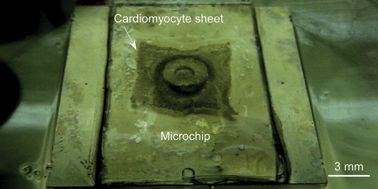An actuated pump on-chip powered by cultured cardiomyocytes†
Abstract
Cellular functions are frequently exploited as processing components for integrated chemical systems such as biochemical reactors and bioassay systems. Here, we have created a new cell-based microsystem exploiting the intrinsic pulsatile mechanical functions of cardiomyocytes to build a cellular micropump on-chip using cardiomyocyte sheets as prototype bio-microactuators. We first demonstrate cell-based control of fluid motion in a model microchannel without check valves and evaluate the potential performance of the bio-actuation. For this purpose, a poly(dimethylsiloxane) (PDMS) microchip with a microchannel equipped with a diaphragm and a push-bar structure capable of harnessing collective cell fluid mechanical forces was coupled to a cultured pulsating cardiomyocyte sheet, activating cell-based fluid movement in the microchannel by actuating the diaphragm. Cell oscillation frequency and correlated fluid displacement in this system depended on temperature. When culture temperature was increased, collective cell contraction frequency remained cooperative and synchronous but increased, while displacement was slightly reduced. We then demonstrated directional fluid pumping within microchannels using cantilever-type micro-check valves made of polyimide. A directional flow rate of nL min−1 was produced. This cell micropump system could be further developed as a self-actuated and efficient mechanochemical transducer requiring no external energy sources for various purposes in the future.


 Please wait while we load your content...
Please wait while we load your content...